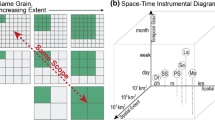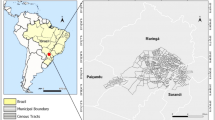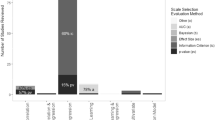Abstract
Indicators are used to draw conclusions about ecological endpoints when these endpoints cannot be measured directly. In many cases, inferences about an endpoint are only possible because assumptions have been made about the relationship between indicator and endpoint; we refer to such indicators as judgement indicators. The validity of inferences made using a judgement indicator can be gauged by examining the known or assumed form of the general relationship between indicator and endpoint. The rules for this kind of inference are a consequence of scale invariance, which originates from measurement theory. For simple indicators comprised of a single indicator measurement, the inferences allowed – equivalence, rank, equality of intervals, and equality of ratios – depend on whether the data are nominal, ordinal, interval, or ratio scaled. For composite indicators containing two or more simple indicators, inferences are also affected by the mathematical form of combination; e.g., whether the terms are summed or multiplied. Standardizing simple or composite indicators can allow inferences about the relative importance of observations, based on the natural range of occurrence. Scale invariance is a particularly important consideration in landscape assessments, since these often make use of judgement indicators.
Similar content being viewed by others
References
Abbruzzese, B. and Leibowitz, S. G.: 1997, ‘A Synoptic Approach for Assessing Cumulative Impacts to Wetlands’, Environmental Management 21(3), 457–475.
Albuquerque, A. L. S. and Mozeto, A. A.: 1997, ‘C:N:P Ratios and Stable Carbon Isotope Compositions as Indicators of Organic Matter Sources in a Riverine Wetland System (Moji-Guaçu River, São Paulo-Brazil)’, Wetlands 17(1), 1–9.
Barber, M. C.: 1994, Indicator Development Strategy. EPA/620/R-94/022, Office of Research and Development, U.S. Environmental Protection Agency, Washington, DC. 74 pp.
Bolton, K. G. E. and Greenway, M.: 1997, ‘A Feasibility Study of MelaleucaTrees for Use in Constructed Wetlands in Subtropical Australia’, Water Science and Technology 35(5), 247–254.
Cairns Jr., J., McCormick, P. V. and Niederlehner, B. R.: 1993, ‘A Proposed Framework for Developing Indicators of Ecosystem Health’, Hydrobiologia 263, 1–44.
Chrisman, N.: 1997, Exploring Geographic Information Systems, John Wiley & Sons, Inc., NY, 298 pp.
Conroy, M. J. and Noon, B. R.: 1996, ‘Mapping of Species Richness for Conservation of Biological Diversity: Conceptual and Methodological Issues’, Ecological Applications 6(3), 763–773.
Cullinan, V. I. and Thomas, J. M.: 1992, ‘A Comparison of Quantitative Methods for Examining Landscape Pattern and Scale’, Landscape Ecology 7(3), 211–227.
Ellis, B.: 1966, Basic Concepts of Measurement, Cambridge University Press, NY, 220 pp.
Flather, C. H., Wilson, K. R., Dean, D. J. and McComb, W. C.: 1997, ‘Identifying Gaps in Conservation Networks: Of Indicators and Uncertainty in Geographic-based Analyses’, Ecological Applications 7(2), 531–542.
Gosselink, J. G. and Lee, L. C.: 1989, ‘Cumulative Impact Assessment in Bottomland Hardwood Forests’, Wetlands 9, 83–174.
Hirvonen, H.: 1992, ‘The Development of Regional Scale Ecological Indicators: A Canadian Approach’, in McKenzie, D. H., Hyatt, D. E. and McDonald, V. J. (eds.), Ecological Indicators, Vol. 2. Elsevier Applied Science, NY, pp. 901–915.
Holling, C. S.: 1992, ‘Cross-scaleMorphology, Geometry, and Dynamics of Ecosystems’, Ecological Monographs 62(4), 447–502.
Hopkins, L. D.: 1977, ‘Methods for Generating Land Suitability Maps: A Comparative Evaluation’, Journal of the American Institute of Planners 43, 386–400.
Karr, J. R.: 1991, ‘Biological Integrity: A Long-Neglected Aspect of Water Resource Management’, Ecological Applications 1(1), 66–84.
Kay, J. J. and Schneider, E. D.: 1992, ‘Thermodynamics and Measures of Ecological Integrity’, in McKenzie, D. H., Hyatt, D. E. and McDonald, V. J. (eds.), Ecological Indicators, Vol. 1. Elsevier Applied Science, NY, pp. 159–182.
Krantz, D. H., Luce, R. D., Suppes, P. and Tversky, A.: 1971, Foundations of Measurement. Volume 1: Additive and Polynomial Representations. Academic Press, NY, 577 pp.
Lancia, R. A., Miller, S. D., Adams, D. A. and Hazel, D. W.: 1982, ‘Validating Habitat Quality Assessment: An Example’, in Forty-Seventh North American Wildlife Conference, pp. 96–110.
Landres, P. B., Verner, J. and Thomas, J. W.: 1988, ‘Ecological Uses of Vertebrate Indicator Species: A Critique’, Conservation Biology 2(4), 316–328.
Larsen, D. P. and Christie, S. J. (eds.): 1993, EMAP-Surface Waters 1991 Pilot Report, EPA/620/R-93/003, Office of Research and Development, U.S. Environmental Protection Agency, Washington, DC. 201 pp.
Luce, D. R., Krantz, D. H., Suppes, P. and Tversky, A.: 1990, Foundations of Measurement. Volume 3: Representation, Axiomatization, and Invariance. Academic Press, NY, 356 pp.
McFarland, B. H., Hill, B. H. and Willingham, W. T.: 1997, ‘Abnormal Fragilariaspp. (Bacillariophyceae) in Streams Impacted by Mine Drainage’, Journal of Freshwater Ecology 12(1), 141–149.
Morrison, M. L., Marcot, B. G. and Mannan, R. W.: 1992, Wildlife-Habitat Relationships. The University of Wisconsin Press, Madison, WI, 343 pp.
Noss, R. F.: 1990, ‘Indicators for Monitoring Biodiversity: A Hierarchical Approach’, Conservation Biology 4(4), 355–364.
O'Neill, R. V., Krummel, J. R., Gardner, R. H., Sugihara, G., Jackson, B., DeAngelis, D. L., Milne, B. T., Turner, M. G., Zygmunt, B., Christensen, S. W., Dale, V. H. and Graham, R. L.: 1988, ‘Indices of Landscape Pattern’, Landscape Ecology 1(3), 153–162.
Ott, W. R.: 1978, Environmental Indices: Theory and Practice, Ann Arbor Science, Ann Arbor, MI, 371 pp.
Peterson, S. A., Carpenter, L., Guntenspergen, G. and Cowardin, L. M. (eds.): 1997, Pilot Test of Wetland Condition Indicators in the Prairie Pothole Region of the United States, EPA/620/R-97/002, Office of Research and Development, U.S. Environmental Protection Agency, Washington, DC, 279 pp.
Rapport, D. J.: 1992, ‘Evolution of Indicators of Ecosystem Health’, in McKenzie, D. H., Hyatt, D. E. and McDonald, V. J. (eds.), Ecological Indicators, Vol. 1. Elsevier Applied Science, NY, pp. 121–134.
Regier, H. A.: 1992, ‘Indicators of Ecosystem Integrity’, in McKenzie, D. H., Hyatt, D. E. and McDonald, V. J. (eds.), Ecological Indicators, Vol. 1. Elsevier Applied Science, NY, pp. 183–200.
Riitters, K. H., O'Neill, R. V., Hunsaker, C. T., Wickham, J. D., Yankee, D. H., Timmins, S. P., Jones, K. B. and Jackson, B. L.: 1995, ‘A Factor Analysis of Landscape Pattern and Structure Metrics’, Landscape Ecology 10(1), 23–39.
Schneider, D. C.: 1994, Quantitative Ecology: Spatial and Temporal Scaling, Academic Press, New York, NY, 395 pp.
Schumaker, N. H.: 1996, ‘Using Landscape Indices to Predict Habitat Connectivity’, Ecology 77(4), 1210–1225.
Scott, J. M., Davis, F., Csuti, B., Noss, R., Butterfield, B., Groves, C., Anderson, H., Caicco, S., D'Erchia, F., Edwards Jr., T. C., Ulliman, J. and Wright, R. G.: 1993, ‘Gap Analysis: A Geographic Approach to Protection of Biological Diversity’, Wildlife Monographs 123.
Simberloff, D. and Cox, J.: 1987, ‘Consequences and Costs of Conservation Corridors’, Conservation Biology 1, 63–71.
Stevens, S. S.: 1946, ‘On the Theory of Scales of Measurement’, Science 103, 677–680.
Stevens, S. S.: 1957, ‘On the Psychophysical Law’, Psychological Review 64(3), 153–181.
Suter, G. W., II.: 1993, ‘A Critique of Ecosystem Health Concepts and Indices’, Environmental Toxicology and Chemistry 12, 1533–1539.
Turgeon, D. D., Bricker, S. B. and O'Connor, T. P.: 1992, ‘National Status and Trends Program: Chemical and Biological Monitoring of U.S. Coastal Waters’, in McKenzie, D. H., Hyatt, D. E. and McDonald, V. J. (eds.), Ecological Indicators, Vol. 1. Elsevier Applied Science, NY, pp. 425–457.
Turner, M. G.: 1989, ‘Landscape Ecology: The Effect of Pattern on Process’, Annual Review Ecology and Systematics 20, 171–197.
VanStraalen, N. M. and Verhoef, H. A.: 1997, ‘The Development of a Bioindicator System for Soil Acidity Based on Arthropod pH Preferences’, Journal of Applied Ecology 34(1), 217–232.
Wiens, J. A.: 1992, ‘What Is Landscape Ecology, Really?’, Landscape Ecology 7(3), 149–150.
Author information
Authors and Affiliations
Corresponding author
Rights and permissions
About this article
Cite this article
Leibowitz, S.G., Hyman, J.B. Use of Scale Invariance in Evaluating Judgement Indicators. Environ Monit Assess 58, 283–303 (1999). https://doi.org/10.1023/A:1006029300850
Issue Date:
DOI: https://doi.org/10.1023/A:1006029300850




